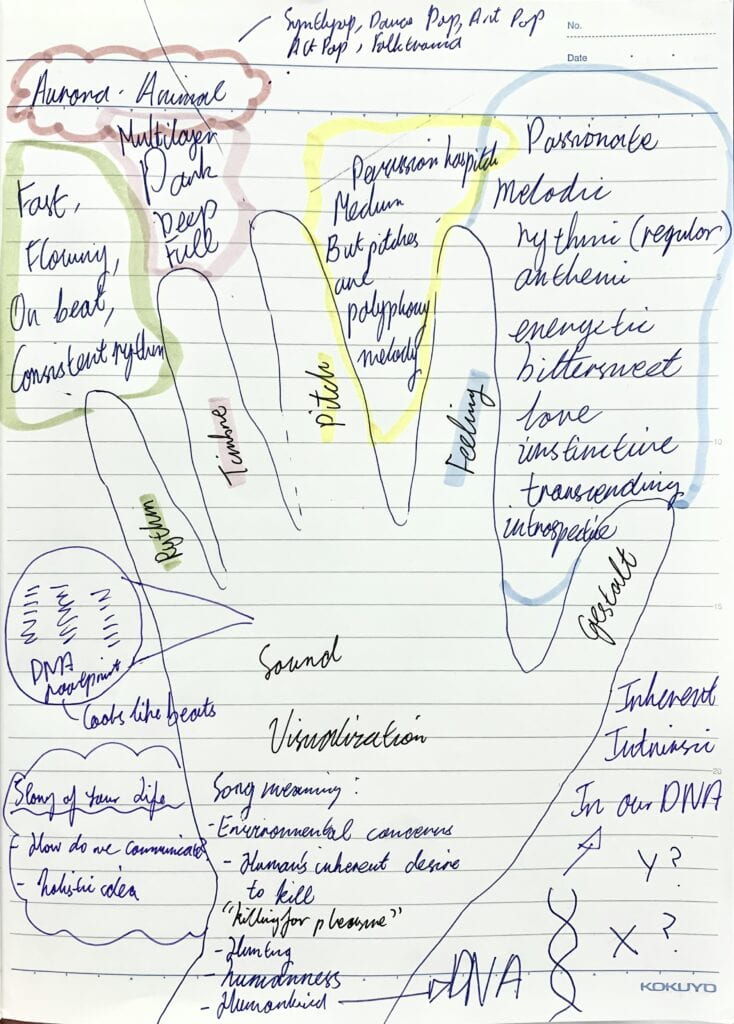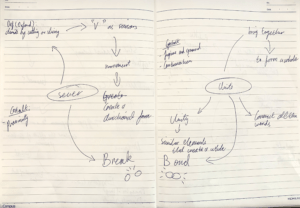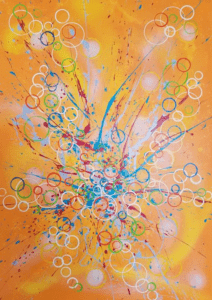
Anita Luo, Sample X, 2023, Print
Click here for better viewing: Sound visualization
Music
Animal by AURORA
Proposal
It is a widely accepted truth that there is a paradox of humanity — we have the capacity to be both good and evil. AURORA’s Animal explores human’s inherent animalistic nature to kill and destroy. Is this in our DNA? Through typography and Gestalt Theory, I’d like to formulate a graphic representation of both the music and the deeper questions of our intrinsic qualities as humans.
Brainstorming
Firstly, I created a mind map for the song. I wrote down whatever impressions I had in mind in hopes of finding connections and meaning.

Inspiration & Conceptual Integration
Concept Brainstorm
Right-click the image below and click on the option “Open image in new tab” for better viewing.

DNA Profile
I was inspired to use DNA profiles as a reference when creating my composition because it relates to the theme of our inherent qualities as humans. Furthermore, I believe science is a strong example of humankind’s hunger for knowledge and the dangers of it — humanity’s natural destruction. Genetic fingerprinting uses Polymerase Chain Reaction (PCR) to amplify a specific sequence of DNA so that it can be studied and compared with other samples. DNA profiling is the process where a specific DNA pattern, called a DNA profile, is obtained from a person or sample of bodily tissue. Most of our DNA is identical to other people’s DNA. However, specific regions vary highly between people. Below is an image of a typical DNA profile:

Music Software and Synth Pad
I also found a connection between the DNA profile and music software due to their similar visual appearance — repeated blocks in different sequences throughout the picture plane.

The same can be said for synth pads.

Lastly, I chose to use the font “Myriad Pro” because it would be more relatable to the audience — evoking a positive audience reception — and it is modern — which relates to the idea of new scientific technology like genetic fingerprinting.
Contextual Research on Media and Composition
I found Richard Skelton’s Visual Poetry enticing because of his use of repeated letter shapes to create rhythm and organic subject matter. The work is about the resurgence of concrete poetry and the influences of digital text and the internet. Due to the irregularity of the placement of the letters, there is a unique texture displayed in this work. I would like to incorporate the same effect in my composition. Furthermore, there is a symmetrical balance within the work which gives the piece a sense of comfort to the viewers.

Process
Step 1: Basic framework
Using the image below as a reference, I first used various letters to create the basic shape of the DNA profile which I then manipulated.


Step 2: Duplicating
After removing the reference I found that the composition looked empty. Thus, I highlighted and copied certain sections of the text and pasted them in various locations to darken the overall tone of the composition. As a result, there was more nuance within the artwork. The repetition of the texts created the illusion of repeated shapes which created a sense of rhythm and familiarity within the composition. I believe that this design element, rhythm, can also be related to the musical rhythm of AURORA’s song. Furthermore, the repetition of shapes suggests the idea of cycles which is prevalent in nature and animals — once again relating back to the idea of inherent essence. Additionally, I also added more letters at the bottom, to show the presence of the deep and full synthesized bassline in the song, while maintaining lines within to show the sheer electronic ambiance present in the song. This line is achieved through the Gestalt theory of proximity and continuity. Lastly, I ensured that there was a sequence in the composition through the shapes because I wanted to depict the regular tempo of the song.
I also enlarged my compositions and cropped the right columns because I found the composition too busy. The label lines on the left and bottom were also adjusted after the size change.

Step 2: Final adjustments
There were a lot of open gaps within my composition so I added more repetition at the top. I strategically placed them in a way to create the sense of the degradation of the shapes because AURORA’s song has a feeling of bittersweetness evoked by the strings — probably because of the aspect of killing. I also aimed to incorporate movement by focusing on making a heavy base in each shape — this created the impression that they were falling which is almost like a game of Tetris or falling blocks. The electronic beeping sounds within the song also give me the impression of falling blocks.
I also utilized full stops and apostrophes to add more details to the background because I found the composition dull. This also mimics the markings that arise when printing from a real printing machine. I also decided to use more “x” and y” letters to reference the X and Y chromosomes in DNA.
While saving the work I ran into a system issue which resulted in the duplication of certain letters. However, I found this accident useful because it added dimension and depth to my artwork. The duplicated letters are smaller which creates a directional force towards the center of the composition.

Audience Reception
During our class critique, I was able to show that I drew inspiration from DNA profiles. However, I do believe that without prior knowledge certain audience members would not find this reference. On the other hand, there are many other perceptions that can be drawn from this composition — one could see music software, synth pads, hair strands, the city, etc.
My composition is not very abstract which contrasts with my peers greatly. However, I took the risk of creating a very rational piece because I find music like AURORA’s very systematic. The repetitive melody and basslines suggest order. Furthermore, science itself has a lot of structure — DNA itself has structure. Thus, I wanted to approach this project in a more logical manner to represent the song and my concept more holistically. Nevertheless, due to the amalgamation of references and concepts, my composition is still abstract in some way in my opinion.
Another critique worth mentioning is my sister’s insight as a non-artist. She finds my work very scientific and at first glance, it is hard to tell whether it is an expression or just an infographic. My composition’s weakness lies in it’s orderly arrangement which can look dull and static to my audience. However, the concept — our inherent qualities as humans — behind my work demands careful consideration. Thus, I did not want to make it look unduly abstract where meaning could be lost or taken lightly. A scientific diagram usually shows results from experiments which are very important evidence to prove a hypothesis and make conclusions.
Rationale
Although most of our DNA is identical to other people’s DNA, there are still specific regions that vary highly between people. Similarly, we as humans all have the capacity to do evil but we all vary significantly in terms of our experiences, upbringing, and background that influence our individual actions. AURORA’s song has a systematic structure. However, there still lies some variety of melodies and additional instrumental elements. Are we intrinsically the same? Maybe, but we all contribute to society differently — the way pitch, rhythm, and timbre influence the feeling of a song — and we all have something unique about us inherently. Even amidst this logical graphic presentation and structured song, there is still life to be found — possibilities.














